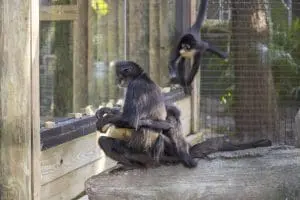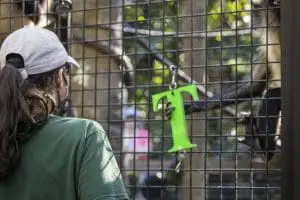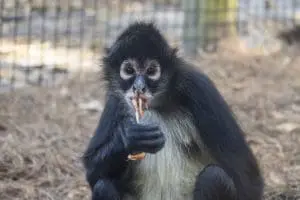

Monkey around with us for a while!
Rise and shine! Our black-handed spider monkey troop and their animal care team took over our social media channels today – but you can get a look at a typical day in their lives right here! Be on the lookout for another Animal Takeover next month.
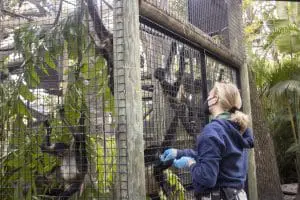 8 a.m. Our spider monkeys have free reign overnight in the three habitats they call home – so there’s no telling where each of them have moved! One thing’s for sure – you’ll rarely find our monkeys in the same place you left them the night before. So, their keepers start the morning by checking in on every one of our 10-member troop and administering any medications if necessary.
8 a.m. Our spider monkeys have free reign overnight in the three habitats they call home – so there’s no telling where each of them have moved! One thing’s for sure – you’ll rarely find our monkeys in the same place you left them the night before. So, their keepers start the morning by checking in on every one of our 10-member troop and administering any medications if necessary.
Then, the keeper starts getting the habitats ready for the day. The spider monkeys’ breakfasts and enrichment items are gathered, and the keeper goes to the first habitat to clean it by picking through pine straw and scrubbing any grungy structures. Enrichment then gets set up – often foraging or scent items (our troop loves cinnamon) – with breakfast tucked inside the foraging items or scattered throughout the habitat. After the keeper ensures everything is in place and nothing is left behind, they close up the double doors to the habitat and open the tunnels leading to the habitat. It’s breakfast time for the monkeys – but their caretaker has to repeat much of the process for the other two habitats!
 11 a.m. Class is in session! Each of our spider monkeys are learning to “station,” or go to their spot (identified by a colorful physical marker that’s the first letter of their name), and stay there for as long as their keeper asks (or until snacks run out). These training sessions need multiple keepers – there are 10 spider monkeys after all! Our spider monkeys, and all our Zoo residents, have the option whether to join in or not – but keepers make it worth their while with lots of snacks!
11 a.m. Class is in session! Each of our spider monkeys are learning to “station,” or go to their spot (identified by a colorful physical marker that’s the first letter of their name), and stay there for as long as their keeper asks (or until snacks run out). These training sessions need multiple keepers – there are 10 spider monkeys after all! Our spider monkeys, and all our Zoo residents, have the option whether to join in or not – but keepers make it worth their while with lots of snacks!
Being able to reliably station is a good building block to other behaviors – like presenting their hands, feet or other body parts for their keepers to examine. This helps keepers know if a spider monkey needs medical attention. One of our spider monkeys, Daisy, knows how to show keepers her back so they can make sure her birth control implant is still in place and not irritated.
1 p.m. Order’s up! Twice a day, keepers head back to our behind-the-scenes commissary to pick up spider monkey diets. These yummy – and nutritious – meals were made fresh by our chefs! Their diets include produce like vegetables and greens, monkey biscuits and primate diet. Check out our post this afternoon to see what the afternoon is like for our troop!
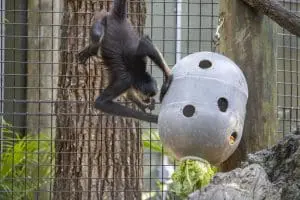 4 p.m. The afternoon with our spider monkey crew is filled with work for their animal care team – and play for the troop.
4 p.m. The afternoon with our spider monkey crew is filled with work for their animal care team – and play for the troop.
Paperwork is never any fun, but it’s so important for animal wellness! Their keepers keep track and log all the enrichment the troop receives, any behavioral changes among the monkeys, any medical updates and more. The rest of the afternoon for the team may include some major projects like replacing or reconfiguring items in a habitat or holding an extra training session.
With three habitats to choose from, our troop can be anywhere in the afternoon! They spend the time chowing down on their afternoon meal, swinging around, napping, interacting with each other – however they feel like spending the time! Before their animal care team heads home, they look over each of our spider monkeys, administer any medications, turn on their heaters if it’s going to be a cold night, and make any last-minute notes.
Thanks for spending the day with our spider monkey troop and their keepers!
Brevard Zoo is an independent, not-for-profit organization that receives no recurring government funding for our operating costs. Your generous support enables us to continue to serve our community and continue our vital animal wellness, education and conservation programs.


